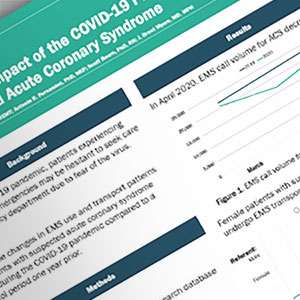ABSTRACTS
Assessing the Impact of the COVID-19 Pandemic on EMS Transport Patterns for Patients with Suspected Acute Coronary SyndromeAuthor: Remle Crowe PhD, NREMT | Research Scientist | ESO Associate Authors: Fernandez, Antonio, R, PhD, NRP | Bourn, Scott, PhD, RN | Myers, J, Brent, MD, MPH |
Introduction: During the first months of the COVID-19 pandemic, Emergency Department visits for time-sensitive conditions including acute coronary syndrome (ACS) declined. Patients who call EMS may refuse hospital transport due to fear of COVID-19 infection. It is unknown whether EMS encounters resulting in non-transport for time-sensitive conditions have changed during the pandemic and whether patterns differ by patient characteristics. Objective: Describe changes in EMS use and transport patterns for patients with suspected ACS during the COVID-19 pandemic compared to a control period one year prior. Methods: This retrospective analysis used prehospital records from the ESO Data Collaborative (Austin, TX). After limiting to agencies contributing records in both time periods, we compared responses for patients with suspected ACS from the first three months of the pandemic (study period: 3/1/2020-5/31/2020) to the previous year (control period: 3/1/2019-5/31/2019). Proportion of EMS responses resulting in non-transport were compared using Chi-square tests. Multivariable logistic regression models were used to assess odds of transport for patients with suspected ACS during each period, controlling for age, sex, and race/ethnicity. Adjusted odds ratios (aOR) and 95% confidence intervals (95%CI) are reported (aOR, 95%CI) Results: Records from 1,241 agencies were included. Total 9-1-1 call volume decreased 5% between the control period (1,131,399) and study period (1,071,868). Non-transports increased from 17% to 19% of all encounters (p<0.001). Total encounters for suspected ACS decreased by 16% (67,697 to 56,969). Suspected ACS encounters resulting in non-transport increased from 6% to 9% (p<0.001). Controlling for age and race/ethnicity, females with suspected ACS were less likely to be transported in the study period (0.76, 0.72-0.81) and control period (0.81, 0.75-0.94) compared to males. Compared to white, non-Hispanic patients, Hispanic patients were less likely to be transported during the study period (0.82, 0.74-0.91) and control period (0.84, 0.75-0.94). Black, non-Hispanic patients were less likely to be transported during the study period only (0.91, 0.84-0.97). Conclusion: EMS encounters for suspected ACS decreased during the first months of the COVID-19 pandemic. More encounters resulted in non-transport, even for patients with suspected ACS. Future work should explore root causes of observed disparities in non-transport by race/ethnicity and gender.
|

